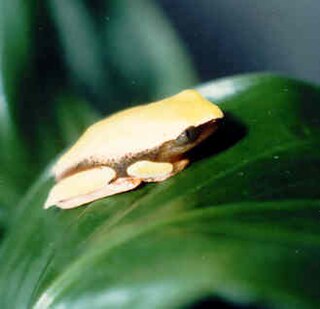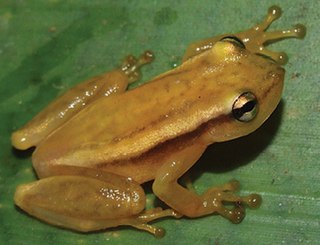
Ranitomeya vanzolinii, also known as the Brazilian poison frog or spotted poison frog, is a species of frog in the Ranitomeya genus, from the poison dart frog family, Dendrobatidae. It is found in the Amazonian rainforests of Brazil and Perú, and possibly Bolivia.

Corythomantis greeningi, occasionally called Greening's frog, is a venomous frog species in the family Hylidae endemic to eastern Brazil, where it lives in the Caatinga habitat. It is usually situated on vegetation, including in bromeliads, and on rock outcrops. Breeding occurs in temporary streams. Although suffering from habitat loss, it is not considered threatened by the IUCN. The specific name greeningi was in honour of Linnaeus Greening (1855–1927), an English businessman and naturalist known for his work on arachnids, reptiles and amphibians.
Phasmahyla guttata, the spotted leaf frog, is a species of frog in the subfamily Phyllomedusinae. It is endemic to Brazil. It lives in forests and near the edges of forests but not outside forests. It has been observed between 50 and 1200 meters above sea level.

Phrynomedusa marginata, the bicolored leaf frog, is a species of frog in the subfamily Phyllomedusinae. It is endemic to Brazil. People have seen it between 600 and 800 meters above sea level.
The Alagoas heart-tongued frog is a species of frog in the family Hylidae, the tree frogs and allies. It is endemic to Brazil, where it is known from coastal regions in Bahia, Alagoas, and Pernambuco. It has been observed as high as 550 meters above sea level.

Phytotriades is a genus of tree frogs in the family Hylidae. As currently delimited, the genus is monotypic and contains Phytotriades auratus, commonly known as the golden tree frog, bromeliad-dwelling treefrog, El Tucuche golden tree frog, or Trinidad heart-tongued frog.
The Alhandra heart-tongued frog is a species of frog in the family Hylidae endemic to Brazil. It has been observed as high as 100 meters above sea level.

Phyllodytes edelmoi is a species of frog in the family Hylidae endemic to Brazil. It has been observed as high as 650 meters above sea level.
Phyllodytes gyrinaethes is a species of frogs in the family Hylidae endemic to Brazil. Its natural habitat is subtropical or tropical moist lowland forests. It has been observed as high as 710 meters above sea level.

The Brazilian heart-tongued frog is a species of frog in the family Hylidae endemic to Brazil's Atlantic forests. It has been observed as high as 600 meters above sea level.

The yellow heart-tongued frog is a species of frog in the family Hylidae endemic to Brazil. It has been observed as high as 650 meters above sea level.

The Bahia heart-tongued frog is a species of frog in the family Hylidae endemic to Brazil's rainforests. It has been observed as high as 800 meters above sea level.
Phyllodytes punctatus is a species of frogs in the family Hylidae endemic to Brazil. People have seen it as high as 140 meters above sea level.
The Maracas heart-tongued frog is a species of frog in the family Hylidae endemic to Brazil. Its natural habitats are subtropical or tropical dry forests, dry savanna, and moist savanna. People have seen this frog between 900 and 1350 meters above sea level.

Phyllodytes wuchereri is a species of frog in the family Hylidae endemic to Brazil in the Atlantic forest in the state of Bahia. This frog has been observed 400 meters above sea level.
Pithecopus ayeaye, also known as the reticulated leaf frog and reticulate leaf frog, is a species of frog in the subfamily Phyllomedusinae. It is endemic to Brazil. P. ayeaye is found in the transition zone between cerrado and Atlantic semi-deciduous forest, laying its eggs on leaves above streams or pools so the tadpoles, when hatched, fall into the water below. This species is under threat from habitat loss resulting from mining activity and fires, and is also affected by pollution from mining and pesticides. Its restricted range is likely to make it particularly vulnerable to these threats.

Xenohyla eugenioi is a species of tree frog in the Hylidae family native to northeastern Brazil in ecotones between the Atlantic Forest and caatingas. It has been found in the Brazilian states of Bahia and Sergipe, approximately 1,000 km away from the other species in its genus, Xenohyla truncata. Like its relative, this frog spends the day hiding in bromeliads, emerging at night to hunt and forage. This frog has been observed between 128 and 960 meters above sea level.

Phasmahyla spectabilis is a species of frog in the subfamily Phyllomedusinae. It is endemic to Brazil and known from the north-eastern Minas Gerais and adjacent southern Bahia. It occurs in fragments of Atlantic Forest at elevations of about 800 m (2,600 ft) above sea level.People have seen it as high as 850 meters above sea level.
Phyllodytes megatympanum is a frog in the family Hylidae endemic to Brazil. It has been observed between 90 and 95 meters above sea level.

Phyllodytes praeceptor is a species of frog in the family Hylidae endemic to coastal areas in the state of Bahia in Brazil. It has also been seen in Serra da Jiboia, 694 m above sea level.













